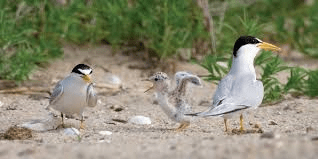We are early risers. Before the sun shines, we step outside to test the weather. The sounds in the air remind us that we live in a densely populated community. Birds call out over the distant freeway noise. Dogs bark in unison. Car engines roar to life as people head off to work. As the day goes on, it gets more difficult to hear the birds—yet our industrial way of life grows louder in a cacophony of incoherent sounds.
When you visit the Seal Beach National Wildlife Refuge, a Friend of the refuge may ask you to close your eyes and reflect upon the sounds you experience. For some, it might be the commercial airlines passing overhead. Others may note the singing birds close by. For young visitors, it’s often the sound of “wind.” Yes, more often than you’d expect, they call out that frequently overlooked feature of our environment. Having recently completed a hearing test, I know that the ability to experience the sound of “wind” does diminish over time.
For the Friends of the Seal Beach National Wildlife Refuge, the sound we acknowledge daily is The Star-Spangled Banner, which resonates through the refuge each morning. Our situation is unique. Tucked away and pristine, our refuge is very fortunate to be located on a military
installation. The creation of the refuge came about for various reasons, one of which was to stop an extension of the 605 freeway being built into the area years ago.
But one thing that always seems to negate our efforts to provide a safe habitat for mammals and migratory visitors? You guessed it. Sound.
Though you can close your eyes in the center of the refuge and listen for birds, trickling water, or plants rustling, it’s nearly impossible to drown out the sounds we unconsciously accept and tolerate, unbeknownst to their effect on our health and well-being. Tires on the road. Sirens passing over the Anaheim Bay Bridge. Over-hyped exhaust systems. Revving engines.
This experience doesn’t quite meet the mark of the vision statement from the May 2012 “Final Comprehensive Conservation Plan” for the Seal Beach National Wildlife Refuge: “As the quiet calm of the morning is interrupted by the clacking of a light-footed clapper rail, school children and other visitors, standing on the elevated observation deck, point with excitement in the direction of the call hoping for a glimpse of the rare bird.”
To achieve “quiet calm” is an optimistic vision and one that I hope will encourage more community involvement in supporting efforts to reduce the burden of industrial life on the natural world. As for the endangered birds that may have called Seal Beach National Wildlife Refuge their home in the past, there are signs that they do hear us and have moved on.
An article in the High Country News periodical (Sept. 2023) entitled “The Blab of the Pave” presented the results of a study on noise pollution and its effects on wildlife within Denali National Park in Alaska, and researchers found that “noise alone could impinge on animals’ lives.” Author Ben Goldfarb discusses the study further in his book Crossings: How Road Ecology Is Shaping the Future of Our Planet.
And how do we humans respond? “Noise is a human-produced pollutant, and, like its etymological root, nausea, it’s unpleasant.”
We cannot turn back the clock and erase the history of our refuge. But we can support efforts not to add to the stresses on humans, wildlife, and the environment and work to find a way to reduce the noise for which we are all responsible.
For now, the best we can offer is partial respite from the noise of the big city—and incredible tours of a stunning wetland environment filled with diverse plants and wildlife. So come visit the Seal Beach National Wildlife Refuge! You might hear the crackling of the rare Ridgway’s rail.
(Probably the rumbling of a naval supply vehicle.) And, just maybe, you can take in the sound of the wind across the wetlands.
We encourage you to embrace your national wildlife refuge and know that “The best way to preserve quiet habitat for wildlife is to not build the damn road.”
References to High Country News and Crossings: How Road Ecology Is Shaping the Future of Our Planet by Ben Goldfarb used with permission.





